Anxious to get back on the water in Minnesota during October migration and primo fall colors, the promise of an exciting afternoon of birding with some photo ops propelled me on as I Iooked forward to catching up with my great friend Andy at the Pelican Lakes. A Bald Eagle and Common Raven seemed like good omens before I turned at the town of Audubon toward my friend Linda’s lake home. Linda was back in Hollywood, but I wanted to check for the Trumpeter Swan families between her summer home and Andy’s place – 3 swan families I observed and photographed in early September.
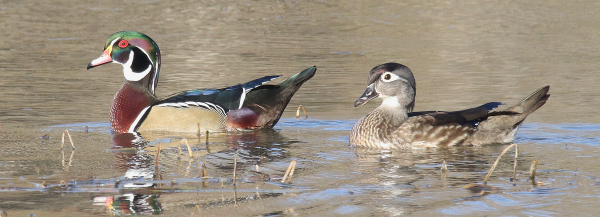
An absolute surprise and delight to start the afternoon photo period was the presence of a few Wood Ducks among a group of swans, geese, and ducks. Eventually some Woodies became more trusting enough to provide some nice photo ops – patience and spending extra time near birds can prove to be fruitful (600mm zoom lens, f-9 aperture, 1/1500 shutter speed, 800 ISO).
The 2 marshes near the road that held swans 6 weeks before were empty, but the third marsh with the beaver lodge still held the distant pair with 3 gray cygnets. Oh well, the swans were a second thought anyway, I was hoping for the near-impossible – a very late season loon in full winter plumage on Andy’s lake. But wait! A small marsh on the edge of colorful woods showed lots of large white bodies with long white necks – Trumpeter Swans. As I slowed down and trees began to obscure the marsh, a gravel road appeared that permit me to get closer to the marsh and the swans.
Better yet, the road directed me to the perfect location at the far end of the marsh where 18 Trumpeters were in sight, most fairly close for photography. That’s when I realized there were also some Wood Ducks, which were even more attractive to my camera! Mixed in with 14 Mallards and 6 Canada Geese, the 7 Wood Ducks appeared to be feeding on grains of wild rice in the water. They were a bit out of the range of my zoom lens, but the big swans were close and showed little concern for my arrival. One pair had a single gray cygnet with them, while another pair was surrounded by 5 big cygnets, some showing a few white feathers already, although they will remain mostly gray until next spring into summer.
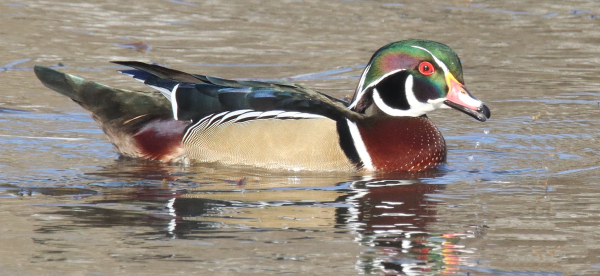
Among the most beautiful birds in the world, every birder hopes for a chance to photograph a drake Wood Duck in full color. While photographing, the chance to observe interactions with other waterfowl in a beautiful fall setting was an unexpected reward for making a focused photo trip to a familiar area during a different period (600mm zoom lens, f-9 aperture, 1/640 shutter speed, 800 ISO).
While the swans provided a variety of photographs, a pair of Wood Ducks finally broke into the open water to provide a few long-range photos. By then I was watching the time as I planned to meet Andy at 3:00, and when the waterfowl eventually moved out of range, I reluctantly left. As I approached Andy’s place I checked Little Pelican for Common Loons and other birds, but saw none, and I checked the lake again from the little hill in front of Andy’s house without seeing a loon or other birds. When I met Andy at his garage, he was ready to hit the water, but when I shared the birds I had encountered down the road, he was game for delaying our water cruise to give the Wood Ducks one more try during prime afternoon sunlight.
We had a chance to visit a bit on the way, and Andy was surprised to see all the waterfowl and how trusting they were in the little marsh. He took an immediate interest in the Wood Ducks, which was further stimulated when he viewed them through 10x binoculars. The Wood Ducks were closer to begin that photo session, providing a few images, but I switched to the swans as the pair with the single cygnet approached the mobile blind and began feeding in the shallows. I explained my description of my mobile blind to Andy, and I pointed out that the swans were working the mud with their huge webbed feet to expose plant tubers.
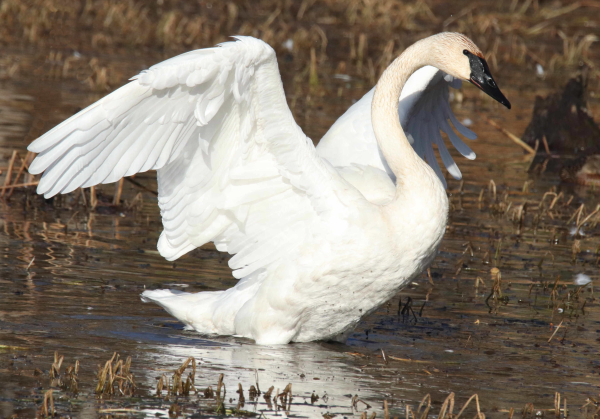
Among a grouping of 18 Trumpeter Swans, many photo opportunities were possible, but this image of an adult flapping its expansive wings emphasized the size and underlined the strength of the largest species of all waterfowl in the world (600mm zoom lens, f-9 aperture, 1/3000 shutter speed, 800 ISO).
In the meantime, some Wood Ducks were moving closer through wild rice stubble. In fact, they tried to join the swans, moving close to try to forage on wild rice floating to the surface but wary not to get within reach of a long swan neck, to avoid a nasty poke, which we witnessed against distant Mallards a couple times. A graceful female Wood Duck and 2 colorful drakes moved closest for photos, with another pair joining them eventually. I was surprised to see the Wood Ducks forage in association with the swans, similar to how I’ve seen Canvasbacks, Redheads, Mallards, and American Wigeons feeding in association with probing Tundra Swans back in Dakota.
Since mid-September I hoped to zero in on Wood Ducks this fall, but I expected the chance would likely come during a trip to the north side of Minneapolis, but this unexpected opportunity was oh-so fun to take advantage of. By 4:15, I knew it was time to head back to see what we could find on the cooling waters in the Pelican Lakes, offshore from Andy’s beach. From the house we hustled down to the lucky pontoon where, as Andy prepared the ship for our photo voyage, my binoculars finally revealed the most elusive bird in Minnesota, or so it seemed – a late-season loon in full winter plumage – Hoooray! It was diving (fishing), in the middle of the lake, and Andy cautiously headed in that direction.
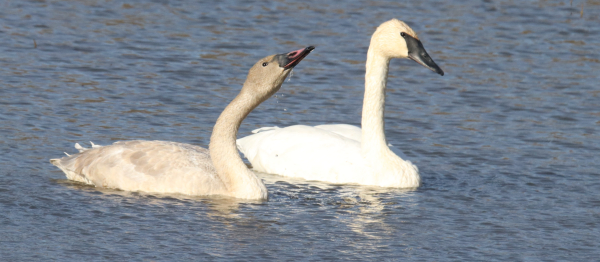
It’s always nice to get some level of action in bird photos, so when the young Trumpeter Swan began drinking in the company of the adult, it created a pleasing option to the 2 swans simply swimming together. Using a zoom lens permitted the option of framing the swans better through the lens (400mm zoom lens, f-9 aperture, 1/1000 shutter speed, 800 ISO).
As I always say: “Timing is everything,” but luck is always helpful too. In this case, it seemed we already made the most of our primo afternoon photographically, and a nice loon photo would be the icing on the cake for me. Considering our past loon encounters on Little Pelican, a photo of a loon sighted on the lake should have been a given, but this was not a true Little Pelican loon of the trusting type. As it turned out, we were hard pressed to get close enough for a quality photo, partly due to the loon’s seeming wariness, but partly because it was intent on fishing, and thereby staying underwater as long as possible, and only rising up several hundred yards away.
As a result, by the time we were close to being in position for a photo, the loon was ready for its next dive, and plop, it was out of sight. Eventually, though, Andy managed to get us in position for a few photos – twice – and I was pretty happy with what I saw in my camera’s LCD playback screen. So when Andy was eager to check for birds in the southeast bay around the far corner, I was ready to see what we might find too – after all, this had turned out to be quite an eventful multi-species photo period, and until now, we had good luck going with the natural flow of the afternoon.
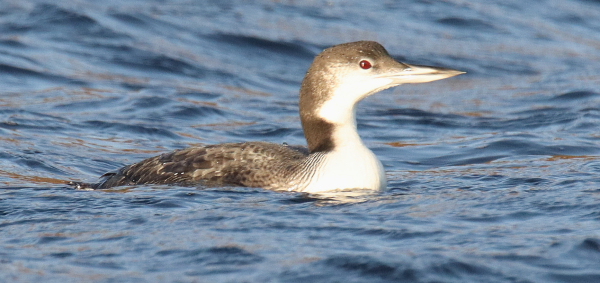
Almost overshadowed by the unexpected chance to photograph Wood Ducks and Trumpeter Swans, it was no less exciting to find a Common Loon in full winter plumage, which was really the primary interest in returning to Minnesota lakes country (600mm zoom lens, f-7 aperture, 1/1000 shutter speed, 800 ISO).
In the bay we found a pair of Trumpeter Swans, about 2 dozen Mallards, and an adult Bald Eagle that was perched near the top of a lakeside tree. Only the eagle provided a photo op, but with many small twigs surrounding it, the images were not great. I waited for the eagle to take wing, but it appeared comfortable on its perch, and we motored on after a couple mintues.
Andy’s next suggestion was to pontoon up the short river to the much larger Pelican Lake as the sun was starting to set. As we emerged at the confluence of the river and big lake, I caught a brief glimpse of a nearby bird on the surface as it dived. Andy continued cautiously, until we caught sight of the bird again, a Common Loon, now a silhouette between us and the setting sun. We followed the loon until it dived again, and Andy angled the boat to position us between the sun and a spot where the loon might surface next. In spite of the sunlight having a bit of a yellow hue, the water color was a creamy blue with tiny ripples – a great setting that eventually was blessed by the appearance of a young Common Loon in winter plumage that provided a couple quick snapshots.
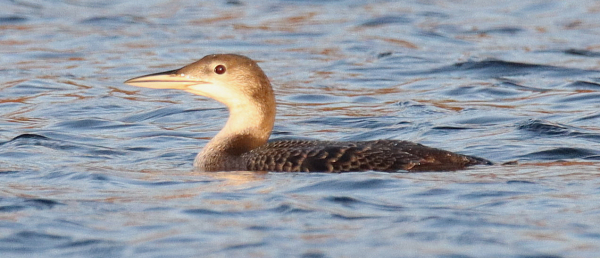
The appearance of a young loon was the final highlight of a memorable afternoon. You can see the light is subdued and slightly yellowed as the sun was setting. Probably making a stopover on its way south to the Gulf Coast, the first-year loon can be differentiated from an adult by its plumage, especially the lighter-colored scalloped edge on each feather on its back. Its eyes are also brown, differing from the red eyes of an adult Common Loon (500mm zoom lens, f-6 aperture, 1/1000 shutter speed, 800 ISO).
Finding a first fall loon and an adult in their respective winter plumages was really a break, and you can see telltale differences between the loons’ plumages – especially the young loon’s lighter-colored scalloped edge on each feather on its back. The eyes are also different colors, red in adults and brown in first year Common Loons.
As seemed to be the theme of this loon cruise, we would spend a lot of time waiting for the loon to surface, watching across the water, waiting for its next appearance in the distance. But our last interaction was different, with the young loon popping up within 25 feet of my camera lens. Andy and I were both surprised by the close position of the loon, and I scrabbled to focus on the bird. I think the loon was a bit surprised too, and by the time I pressed the shutter button, all that showed in the resulting photo were some of its back feathers surrounded by water – and that was the last look we had. We waited, watched, and marveled at how a loon could disappear, surrounded by such an expanse of open water. The best bet is that during the last dive, the loon passed through an underwater portal into another dimension – ha-ha. On that note, we headed for a local pub on the shore of Lake Eunice for a nice dinner, then I headed back westward – Thanks again Andy!
I can’t convey what euphoria I felt during and after such an enjoyable, fulfilling, and rewarding afternoon while observing and photographing a variety of interesting birds that would attract any of us, especially with a camera in hand during a prime fall sunlight period. I wish a photo period like that for you – different birds at different locations no doubt, but a bird photography experience that yields more and more photo opportunities until the sun goes down. Good Luck during upcoming photo expeditions, near and far!
Article and Photographs by Paul Konrad
Share your bird photos and birding experiences at editorstbw2@gmail.com